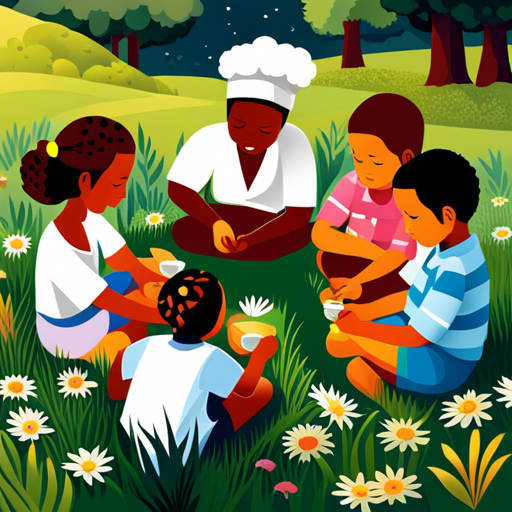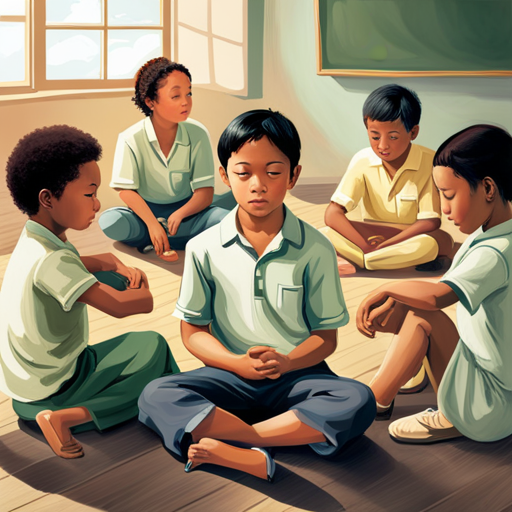"Cherishing Little Steps - A Haven for Baby and Family Journeys"
Teaching Mindfulness to Kids
Imagine a world where children have the ability to calm their minds, focus their attention, and find peace within themselves. Teaching mindfulness to kids can help make this world a reality.
By introducing simple yet powerful techniques, you can guide children on a journey of self-discovery and emotional well-being. In this intimate exploration, you will discover the importance of mindfulness for kids and the incredible benefits it brings.
You will also learn practical tips for creating a mindful environment at home and engaging activities that teach mindfulness in a fun and interactive way. Whether you are a parent or an educator, this guide will support you in nurturing mindfulness as a lifelong skill for the children you care about.
Key Takeaways
- Mindfulness is crucial for children’s overall well-being and development.
- It helps children develop self-awareness, emotional regulation, and empathy.
- Mindfulness equips children with valuable tools to navigate life’s challenges.
- It helps kids manage stress and anxiety.
The Importance of Mindfulness for Kids

Teaching kids mindfulness is crucial for their overall well-being and development. Mindfulness is the practice of being fully present in the moment, without judgment or distraction. It helps children develop self-awareness, emotional regulation, and empathy. By teaching mindfulness to kids, we equip them with valuable tools to navigate the challenges of life.
The benefits of mindfulness for children are numerous. Firstly, it helps them manage stress and anxiety. Mindfulness techniques, such as deep breathing or body scans, allow kids to calm their minds and bodies when they feel overwhelmed. Secondly, mindfulness improves concentration and focus. By training their attention, children become better able to stay engaged in tasks and resist distractions. Thirdly, mindfulness enhances emotional well-being. It helps kids recognize and accept their emotions without judgment, allowing them to respond to them in a healthy way.
There are various mindfulness techniques that can be taught to children. One popular technique is the ‘breathing buddy’ exercise. Kids lie down and place a stuffed animal on their bellies. They observe how the toy rises and falls with each breath, helping them focus on their breath and calm their minds. Another technique is the ‘mindful eating’ exercise. Children are encouraged to eat a snack slowly, noticing the taste, texture, and smell of the food. This practice promotes mindful eating habits and cultivates gratitude for the nourishment.
Understanding the Benefits of Mindfulness
To fully grasp the value of mindfulness for children, it’s important to understand the numerous benefits it offers. Mindfulness has a positive impact on child development in many ways. Firstly, it helps children manage their emotions better. By practicing mindfulness, kids learn to identify and regulate their feelings, which leads to improved emotional well-being.
Mindfulness also enhances concentration and focus. When children are mindful, they’re better able to pay attention to their tasks and stay present in the moment, which can improve their academic performance. Additionally, mindfulness promotes better self-awareness. Children who practice mindfulness develop a deeper understanding of their thoughts, feelings, and actions, leading to increased self-confidence and self-esteem.
Furthermore, mindfulness helps children develop empathy and compassion. By being mindful, kids learn to be more present and attentive in their interactions with others, fostering stronger relationships and a greater sense of connection. Mindfulness also reduces stress and anxiety. It teaches children techniques to calm their minds and bodies, allowing them to manage stress more effectively and improve their overall well-being.
Tips for Introducing Mindfulness to Kids

To introduce mindfulness to kids, you can start by incorporating simple, accessible practices into their daily routines. Mindfulness techniques can be introduced in a fun and engaging way, making it easier for children to understand and incorporate into their lives. Here are some tips to help you get started:
| Tip | Description | Example |
|---|---|---|
| 1 | Start with breathing exercises | Teach your child to take deep breaths in through the nose and out through the mouth, focusing on the sensation of their breath. |
| 2 | Practice mindful eating | Encourage your child to eat slowly and pay attention to the flavors, textures, and smells of their food. |
| 3 | Use guided visualizations | Guide your child through a calming visualization exercise, such as imagining themselves in a peaceful place or visualizing their worries floating away. |
| 4 | Incorporate mindful movement | Encourage your child to engage in activities like yoga or tai chi, focusing on the sensations in their body as they move. |
Creating a Mindful Environment at Home
Create a calm and peaceful atmosphere in your home to foster mindfulness in your kids. By creating a mindful environment, you can help your children develop a greater sense of awareness and presence in their daily lives.
One way to do this is by establishing a mindful routine. Encourage your kids to start their day with a few minutes of quiet reflection or meditation. This will help them set a positive intention for the day ahead.
Incorporating mindfulness into daily life is another important aspect of creating a mindful environment. Encourage your children to be fully present during meals by encouraging them to chew their food slowly and savor each bite. Encourage them to put away electronic devices during family time to foster better connection and presence.
Creating a designated space for mindfulness activities can also help create a mindful atmosphere at home. Set up a quiet corner or a cozy nook where your children can go to practice mindfulness. Fill this space with calming elements such as soft cushions, soothing music, or plants to create a peaceful ambience.
Engaging Activities to Teach Mindfulness

Get your kids involved in fun and interactive mindfulness activities to help them develop a greater sense of awareness and presence. Here are three engaging activities that you can try with your children:
-
Outdoor Mindfulness Scavenger Hunt: Take your kids outside and create a scavenger hunt that encourages them to be present in their surroundings. Give them a list of things to find, such as a smooth rock, a leaf of a certain color, or the sound of birds chirping. As they search for these items, encourage them to use all their senses and really pay attention to their surroundings.
-
Mindful Art Therapy: Set up an art station with various art supplies like paints, markers, and colored pencils. Encourage your children to express their thoughts and emotions through art. Remind them to focus on the process rather than the end result. Encourage them to let go of any judgments or expectations and just enjoy the act of creating. This activity can help children develop mindfulness, as they become fully engaged in the present moment while expressing themselves creatively.
-
Nature Walk Meditation: Take your children on a nature walk and guide them through a walking meditation. Encourage them to notice the sensation of their feet touching the ground, the sound of their breath, and the sights and smells of nature. This activity can help children cultivate a sense of calmness and connection with the natural world.
Supporting Mindfulness in the Classroom

Incorporate mindfulness practices into your classroom to foster a sense of calm and presence among your students. Promoting mindfulness in school is beneficial for both students and teachers alike. By fostering mindfulness in educational settings, you can create a positive and supportive learning environment that encourages focus, self-regulation, and emotional well-being.
Start by introducing simple mindfulness exercises that can be easily integrated into daily routines. For example, you can begin each day with a short guided breathing exercise or take a few moments before a test to practice mindful awareness of thoughts and feelings.
Another effective way to support mindfulness in the classroom is by creating a designated calm corner or quiet space. This can be a cozy area with cushions, soft lighting, and calming decorations. Encourage students to use this space whenever they need a moment to relax and refocus.
In addition, incorporate mindfulness activities into your lessons. For example, during a science lesson, guide students in engaging their senses and fully experiencing the topic at hand. This helps them develop a deeper understanding and connection to the subject matter.
Remember to lead by example. Show your students how to be present and mindful by practicing it yourself. Take moments throughout the day to pause, breathe, and ground yourself. This not only benefits your own well-being but also sets a positive example for your students.
Nurturing Mindfulness as a Lifelong Skill
To continue nurturing mindfulness as a lifelong skill, it’s essential to consistently reinforce and practice mindfulness techniques in everyday life. Developing mindfulness habits and incorporating mindfulness into daily routines can help you cultivate a deeper sense of awareness and presence.
Here are three ways you can integrate mindfulness into your daily life:
-
Mindful breathing: Take a few moments each day to focus on your breath. Close your eyes, inhale deeply through your nose, and exhale slowly through your mouth. Notice the sensation of the breath entering and leaving your body. This simple practice can help you calm your mind and relax your body.
-
Mindful eating: Instead of rushing through meals, take the time to savor each bite. Pay attention to the flavors, textures, and smells of the food. Chew slowly and fully experience each mouthful. By practicing mindful eating, you can develop a greater appreciation for food and nourish your body in a more mindful way.
-
Mindful walking: Whenever you have the opportunity, take a mindful walk. Pay attention to the sensation of your feet touching the ground, the movement of your body, and the sounds around you. Notice the details of your surroundings, such as the colors of the flowers or the feel of the breeze on your skin. Walking mindfully can help you feel more connected to the present moment and the world around you.
Frequently Asked Questions
How Can Mindfulness Benefit Children’s Physical Health?
Mindfulness benefits your physical health by helping you stay focused, reduce stress, and improve sleep. Incorporating mindfulness into physical education can boost your body awareness, coordination, and overall well-being.
Are There Any Potential Risks or Drawbacks to Teaching Mindfulness to Kids?
Are there any potential risks or drawbacks to teaching mindfulness to kids? While mindfulness can have many benefits for children’s physical and emotional well-being, it’s important to consider age-appropriate techniques and best practices to ensure its effectiveness and avoid any potential concerns.
Can Mindfulness Help Children With Attention Deficit Hyperactivity Disorder (Adhd)?
Mindfulness can help you with ADHD by improving your executive functioning skills, like focus and organization. It can also help you regulate your emotions, so you feel calmer and less overwhelmed.
What Age Range Is Most Appropriate for Introducing Mindfulness to Children?
Introducing mindfulness to children at a young age has numerous benefits. Research shows that kids as young as preschoolers can benefit from mindfulness practices, improving focus, self-regulation, and overall well-being. So start early and teach them well!
Are There Any Specific Mindfulness Techniques or Exercises That Are Particularly Effective for Kids?
There are plenty of mindfulness activities for children that can be really effective. Incorporating mindfulness into school curriculum is a great way to introduce kids to these techniques and help them develop important skills for life.
Conclusion
So, now you know all about teaching mindfulness to kids! It’s like giving them a special superpower to stay calm and focused.
By creating a mindful environment at home and engaging in fun activities, you can help them develop this lifelong skill.
And don’t forget, teachers can also support mindfulness in the classroom.
So, let’s get started on this amazing journey of mindfulness together!


